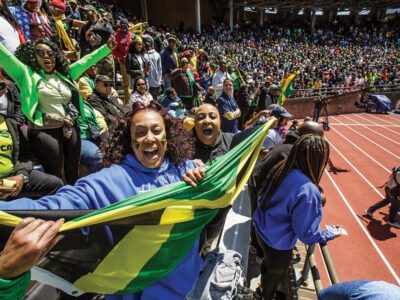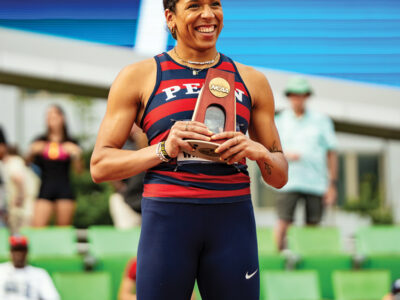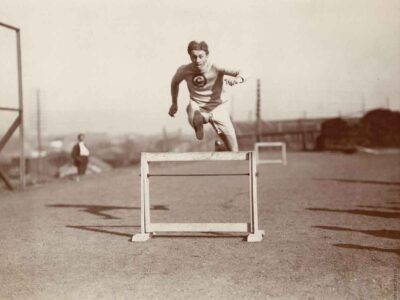
By David Porter | To hear Samantha Crook EAS’05 W’05 tell it, it was more benevolence than design that started her off on a path to becoming one of the nation’s 25 best collegiate athletes at her specialty. She was a sophomore at Randolph High School in northern New Jersey and already an accomplished gymnast when a senior teammate asked her for a favor that seems odd even now, in the retelling.
“She came up to me and said, ‘I’d really like to get into Harvard.’ And she was in line to be the valedictorian, but she felt she needed that little something extra to get her in. So she said, ‘I was thinking about pole vaulting,’” Crook said recently. “She would have been the only girl going into the fieldhouse and it would have been basically walking in through the boys’ track locker room. She said, ‘I don’t want to do that by myself—will you pole vault with me for two weeks just until I make some friends?’ I said, ‘I don’t know, I’ve got a lot of commitments.’ She said, ‘It’s just going to be for two weeks, please please please.’ So I finally said fine. And that’s how I got started.”
Six years later, Crook leaves Penn as the school’s record-holder in the event and with several other notable accomplishments in tow, including qualifying for the NCAA outdoor championships in Sacramento, California, in June—where she improved on her school record with a jump of 13 feet, 1 1/12 inches, barely missing qualifying for the championship final. (Senior Courtney Jaworski reached the men’s 800-meter final and ran a personal-best 1:46.70 to earn All-America status. Sophomore Kyle Calvo jumped 24-1 3/4 in the long jump, missing qualifying for the final by less than an inch.)
In some ways Crook’s progression has mirrored that of her event, which was one of the few left that were contested only by men. The NCAA added the pole vault for women to its Division I national championships in 1998—77 years after the meet began including the men’s pole vault—though female vaulters had already been competing at the collegiate level for several years by then. For Crook, the reverse was true in New Jersey: the event was not contested at the county and dual-meet level, but was held at the state high-school championships. “They basically said anybody who is female and wants to take a pole and compete at the New Jersey state championships, they could go right ahead,” Crook recalled. “And 35 girls showed up.”
Crook found that her gymnastics experience translated seamlessly to the pole vault, which requires similar upper-body strength and body awareness. She became proficient enough that she wound up doing what countless high-school girls have done in the pre- and post-Title IX era, which was to compete on the boys’ team. She finished seventh at the county championships and got used to the funny looks she’d receive from other competitors and officials when she unpacked her pole and warmed up before a meet. “At some of the bigger relay meets my senior year, guys would come up to me and say, ‘What are you doing here?’ Then they’d ask what my best was, and they’d kind of gasp and then turn around and make fun of their teammates for me being better than them.”
The pole vault is unique in track and field in that it requires athletes to not merely propel an implement, but to use it to translate speed into height. It demands strength and coordination plus an unwavering attention to technique, and when all those components blend smoothly, it can produce what has been described as a mid-air ballet. The learning curve is steep, however, as Crook discovered when she started out. Her breakthrough came in the spring of her senior year in high school, two weeks before the state championships; like a pitcher who suddenly finds he has perfected a curveball, Crook went down the runway at practice one day and felt the pole bend for the first time.
“That’s a huge step for beginning vaulters,” she said. “Before, the pole was pretty much straight the whole time, so it was kind of like vaulting in the old days on the steel poles, and that just doesn’t work as well. Then all of a sudden that day at practice, the pole just bent and it swung me up in the air and suddenly I was clearing 10 feet, whereas I’d been clearing 8 feet before.”
By her freshman year at Penn. she had already set the school record at 12 feet, 7 inches, and she went on to earn All-Ivy and All-East honors and won the college division at the Penn Relays this spring. ““She worked so hard,” said Penn coach Gwen Harris. “I kind of knew she could win, and I felt if she could win something that would be a positive step.” Crook followed that with a vault of 13 feet, 1 inch to win the ECAC championships in May and qualify her for the NCAA championships.
“It’s so exciting to be out here,” Crook said the day before competing at Sacramento. “It’s kind of been a goal of mine since freshman year. Making it here was the hard part. I don’t think I can disappoint myself in any way.”
When basketball practice begins in October, Gil Jackson won’t have the prefix “long-time assistant coach” in front of his name for the first time in … well, a long time. Jackson was hired last month to be the head coach at Howard University in Washington, D.C., after 16 years on the sideline at the Palestra.
Often a bridesmaid in coaching searches—he’d been considered for jobs at Columbia and Dartmouth, and the Howard position in 1998—Jackson, 57, signed on for a major rebuilding job when he caught the Bison’s bouquet. Howard hasn’t won a Mid-Eastern Athletic Conference regular season or tournament title in 13 years, and finished 5-23 last season, 2-16 in the league. It’s a far cry from Jackson’s nine Ivy titles in 16 years as Fran Dunphy’s right-hand man, during which he cut a dapper figure on the sidelines with his trademark suspenders and bow tie.
“It’s mixed emotions,” Jackson said last month as he went about tying up loose ends on campus. “I’ve built a lot of special relationships here. The players are happy for me to get the opportunity. They’re great kids and I’m going to miss them. You always had the excitement of the Big Five games and the Ivy games at the Palestra, and I don’t know if you can duplicate that.”
David Porter C’82 writes for the Associated Press.




